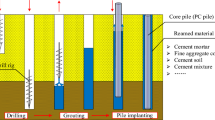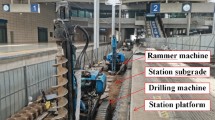Abstract
When pervious concrete is used as pile material, both high strength and water permeability will be available. By comparing the strength and permeability of pervious concrete with different aggregate size (3–5 mm and 4–6 mm) and porosity (20%, 25%, 30% and 35%), the recommended aggregate size (3–5 mm) and porosity (30%) can be achieved. To investigate the installation effect and bearing characteristics of the pervious concrete pile composite foundation, the excess pore water pressure, settlement, pile-soil stress ratio and skin friction were recorded in the model test. Results show that, compared with the impervious pile, the pervious pile can significantly accelerate the dissipation of excess pore water pressure after pile installation, and in the loading test can shorten the consolidation time by 30.3%, increase the skin friction 0.12 kPa averagely, reduce the peak value of excess pore water pressure by 30.2%, and increase the characteristic value of bearing capacity by 43.2%. When the linear penalty method is applied, and the friction coefficient is 0.6, compared with the test, the deviation of simulated skin friction is the largest, being about 15%, so in general the model test results are reliable.
Similar content being viewed by others
References
ACI (2006) Pervious concrete. ACI 522R-06, American Concrete Institute (ACI), Farmington Hills, MI, USA
API (1987) Recommended practice for planning, designing and constructing fixed offshore platforms: API recommended practice, 2A (RP 2A), 17th edition. American Petroleum Institute (API), Washington DC, USA
ATG (2013) Contact constraint enforcement methods in Abaqus/Standard. Abaqus Theory Guide (ATG), Version.6.13
Chen J, Sheng Q, Liu XM, Zhu ZQ, Leng XL, Zhang YH, Chen GL (2013) An production method of solid model layered tamping for the pseudo-earthquake shaking table test. Chinese Patent No.201310154909.8, Institute of Rock and Soil Mechanics, Chinese Academy of Sciences, Wuhan, China
CJJ/T 135-2009 (2009) Technical specification for pervious cement concrete pavement. CJJ/T 135-2009, China Architecture & Building Press, Beijing, China, 4–5
Cosic K, Korat L, Ducman V, Netinger I (2015) Influence of aggregate type and size on properties of pervious concrete. Construction and Building Materials 78:69–76, DOI: https://doi.org/10.1016/j.conbuildmat.2014.12.073
Cui XZ, Ou JQ, Zhang N, Gao ZJ, Sui W (2013) Strength-permeability model of pervious cement concrete. Journal of Civil, Architectural and Environmental Engineering 35(4):114–120 (in Chinese)
Cui XZ, Wang C, Zhou YX, Zhang N, Gao ZJ (2012) Anti-earthquake mechanism of pervious concrete pile composite foundation. Journal of Shandong University (Engineering Science) 42(4):86–91 (in Chinese)
Cui XZ, Zhang J, Chen D, Li SC, Jin Q, Zheng YJ, Cui SQ (2018) Clogging of pervious concrete pile caused by soil piping an approximate experimental study. Canadian Geotechnical Journal (55):999–1015, DOI: https://doi.org/10.1139/cgj-2017-0238
DB37/T 5214-2018 (2018) Technical code for composite foundation of pervious concrete pile. DB37/T 5214-2018, China Building Materials Press, Beijing, China, 9–10
Deo O, Neithalath N (2011) Compressive response of pervious concretes proportioned for desired porosities. Construction and Building Materials 25(11):4181–4189, DOI: https://doi.org/10.1016/j.conbuildmat.2011.04.055
GB/T 50783-2012 (2012) Technical code for composite foundation. GB/T 50783-2012, China Planning Press, Beijing, China, 8–14
Ge JK, Tan YF, Zhou ZD, Wang HY (2020) Study on characteristics of pile-net composite foundation at 500 kV substation in China. Geotechnical Research 7(3):153–160, DOI: https://doi.org/10.1680/jgere.20.00012
Huang Y, Mei GX, Wang YK (2016a) Laboratory model experimental investigation of permeable pipe piles. Journal of Hebei University of Engineering (National Science Edition) 33(3):18–23 (in Chinese)
Huang Y, Wang J, Mei GX (2016b) Model experimental study of accelerating dissipation of excess pore water pressure in soil around a permeable pipe pile. Rock and Soil Mechanics 37(10):2893–2898+2908, DOI: https://doi.org/10.16285/j.rsm.2016.10.021 (in Chinese)
JGJ 79-2012 (2012) Technical code for ground treatment of buildings. JGJ 79-2012, China Architecture & Building Press, Beijing, China, 41–45
JGJ 94-2008 (2008) Technical code for building pile foundations. JGJ 94-2008, China Architecture & Building Press, Beijing, China, 109–112
JGJ 340-2015 (2015) Technical code for testing of building foundation soils. JGJ 340-2015, China Architecture & Building Press, Beijing, China, 34–37
Liu ZB, Liu SY, Jing F, Ju J, Li W, Ji FQ (2015) Pore pressure response of composite foundation in interactive marine and terrestrial deposit of Yangtze River Estuary. Chinese Journal of Geotechnical Engineering 37(S2):91–95, DOI: https://doi.org/10.11779/CJGE2015S2019 (in Chinese)
Liu ZB, Liu SY, Zhou BM, Jing F, Ji FQ (2014) Geological genesis and spatial variability characteristic of the interactive marine and terrestrial soft deposit in Yangtze River Estuary. Chinese Journal of Underground Space and Engineering 10(1):102–108 (in Chinese)
Nguyen DH, Sebaibi N, Boutouil Mohamed, Leleyter L, Baraud F (2014) A modified method for the design of pervious concrete mix. Construction and Building Materials 73:271–282, DOI: https://doi.org/10.1016/j.conbuildmat.2014.09.088
Ni LS, Suleiman MT, Raich A (2016) Behavior and soil-structure interaction of pervious concrete ground-improvement piles under lateral loading. Journal of Geotechnical and Geoenvironmental Engineering 142(2):04015071, DOI: https://doi.org/10.1061/(ASCE)GT.1943-5606.0001393
NPCGIS (2020) National platform for common geospatial information services. People’s Republic of China (PRC), Retrieved May 10, 2021, https://www.tianditu.gov.cn/
Suleiman MT, Ni LS, Raich A (2014) Development of pervious concrete pile ground-improvement alternative and behavior under vertical loading. Journal of Geotechnical and Geoenvironmental Engineering 140(7):04014035, DOI: https://doi.org/10.1061/(ASCE)GT.1943-5606.0001135
Sun SC (1981) Delta sediments of the changing delta and its characteristics. Acta Oceanologica Sinica 3(1):97–113 (in Chinese)
Tang XQ, Xie Y, Xie SB, Wen ZK (1993) In-situ testing technology for foundation engineering. China Railway Publishing House Co., Ltd., Beijing, China, 268–273
Torres A, Hu J, Ramos A (2015) The effect of the cementitious paste thickness on the performance of pervious concrete. Construction and Building Materials 95:850–859, DOI: https://doi.org/10.1016/j.conbuildmat.2015.07.187
Wang W, Nie QK, Wang YH, Jia XX, Wang MS (2015) Experimental study on the bearing characteristics of composite foundation. China Civil Engineering Journal 48(s1):196–200 (in Chinese)
Wang HX, Zhang WH, Liu YS (2018) Study on triaxial shear test of saturated silt in Jiangsu coastal area. Port Engineering Technology 55(2):111–115, DOI: https://doi.org/10.16403/j.cnki.ggjs20180227 (in Chinese)
Wen L, Kong GQ, Li QS, Zhang ZD (2020) Field tests on axial behavior of grouted steel pipe micropiles in marine soft clay. International Journal of Geomechanics 20(6):06020006, DOI: https://doi.org/10.1061/(ASCE)GM.1943-5622.0001656
Wu CF, Ji Y, Guo WC, Qiao FF (2018) Time effect analysis and calculation method of pile-soil stress ratio of rigid pile composite foundation. China Journal of Highway and Transport 31(3):30–37 (in Chinese)
Wu YK, Liu SY, Hong ZS (2005) Relation between physical properties and deposit environment of stratum in North of Jiangsu Province and Changjiang River delta. Hydrogeology and Engineering Geology 2:49–52 (in Chinese)
Yu L (2013) In-situ study of working property of rigid pile composite foundation. High Speed Railway Technology 4(3):41–46 (in Chinese)
Zhang J, Cui XZ, Lan RY, Zhao YL, Lv HB, Xue Q, Chang CL (2017) Dynamic performance characteristics of pervious concrete pile composite foundations under earthquake loads. Journal of Performance of Constructed Facilities 31(5):04017064, DOI: https://doi.org/10.1061/(ASCE)CF.1943-5509.0001056
Zhang N, Cui XZ, Zhang J, Zhou YX, Gao ZJ, Sui W (2013) Settlement-controlling and pressure-reduction effect of pervious concrete pile under the action of embankment load. Journal of Shandong University (Engineering Science) 43(4):80–86 (in Chinese)
Zhang ZH, Wang QF, Yang J (2008) Influence factors of compressive strength and permeability of pervious concrete. Concrete (3):7–9 (in Chinese)
Zhao F, Hu HS, Yang GS, Hou MX (2017) Development of the model box design and soil sample preparation technology for pile-soil model test. Low Temperature Architecture Technology 39(7):66–70 (in Chinese)
Zhong R, Wille K (2016) Compression response of normal and high strength pervious concrete. Construction and Building Materials 109:177–187, DOI: https://doi.org/10.1016/j.conbuildmat.2016.01.051
Zhou XP, Mei GX (2014) Finite element simulation of permeable pipe pile driving considering consolidation process. Rock and Soil Mechanics 35(S2):676–682, DOI: https://doi.org/10.16285/j.rsm.2014.s2.097 (in Chinese)
Zhou TH, Wang F, Zhao H, Gao GY (2015) Bearing capacity tests on multi-type-pile composite foundation with rigid cap. Chinese Journal of Geotechnical Engineering 37(1):105–111, DOI: https://doi.org/10.11779/CJGE201501012 (in Chinese)
Acknowledgments
Not Applicable
Author information
Authors and Affiliations
Corresponding author
Rights and permissions
About this article
Cite this article
Cai, J., Du, G., Xia, H. et al. Model Test and Numerical Simulation Study on Bearing Characteristics of Pervious Concrete Pile Composite Foundation. KSCE J Civ Eng 25, 3679–3690 (2021). https://doi.org/10.1007/s12205-021-1522-7
Received:
Revised:
Accepted:
Published:
Issue Date:
DOI: https://doi.org/10.1007/s12205-021-1522-7




